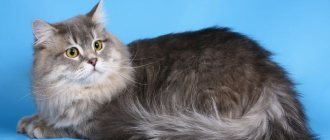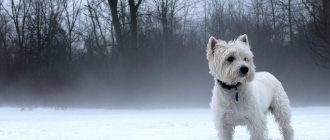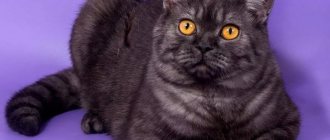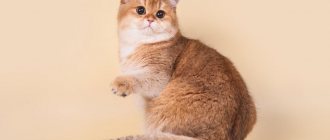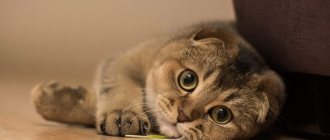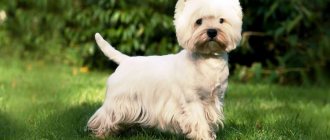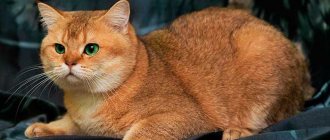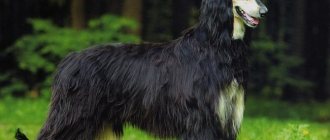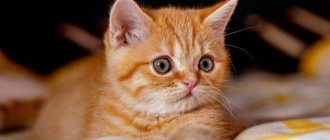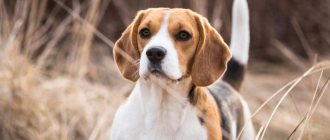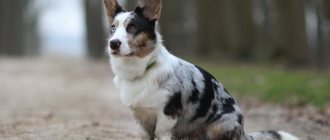Among Scottish cats, predominantly shorthaired, the Highland Straight breed stands out, a photo of which is presented in the article. This is a relatively rare variety; nurseries that breed them are not available in all cities. Highland Straight cats are graceful, with straight ears and luxurious fur. Fluffy babies with a good-natured character rarely conflict with others.
Cute light colored kitten
History of the breed
A new breed of Highland Straight, the Scottish Longhaired Straight cat, was recognized in the 1970s. It was obtained as a result of breeding work. Persian cats were crossed with British cats to create a variety of colors. Then the British began to be crossed with Scottish Folds to increase the number of fold-eared individuals. As a result, an interesting long-haired and straight-eared Highland Straight breed appeared.
Wonderful smoky color
Interesting! The word "highland" comes from the name of the Scottish highlands.
The Scottish Highland Straight is a rare and exquisite breed. Although it was developed relatively recently, it has its own characteristics.
- Longhaired Scottish cats, photos of which are presented in the article, trace their origins to a wild cat that lived in the Scottish mountains back in the 18th century.
- The Highland Straight was crossed with the British and Persians. This relationship explains their beautiful coat and wide range of colors.
- Highland Straights are crossed with Fold cats/females, so different kittens are produced in the same litter.
- The Highland Fold is a rare breed. By getting such a pet, the owner essentially becomes a collector of rare specimens.
Feeding
The high adaptability of cats to different conditions made Highland Folds absolutely unpretentious to food. They eat whatever is offered: canned food, natural or dry. But breeders recommend sticking to a natural diet. At the same time, it is necessary to monitor the variety, completeness and balance of the diet.
A representative of the Highland Fold breed will need frozen meat, fish, cereals, vegetables, vegetable oil and dairy products. It is absolutely unacceptable to feed cats human food. Periodically it is necessary to supplement the diet with vitamins and minerals. This is especially true when it comes to molting. The purebred Highland Fold, curious and sociable, looks at the world with wide open eyes, which are in touching harmony with his ears pressed to his head and a fluffy cloud of fur. Such a pet will not throw a tantrum and will not make a scandal. The positivity emanating from a cat will cope with any stress in the owner’s life.
Psychology
The Scottish Highland Straight has a good-natured and balanced character. These cats are very smart, neat and attached to their owner. They are peaceful and love being in the company of people, and they are also easy to train.
Highland Straights are peaceful and intelligent cats
Highland Straight kittens, like Maine Coons and British babies, are very playful, they can frolic for a long time both with the owner and with each other. Adults are characterized by independence; they themselves are not so persistent in drawing attention to themselves. Cats are calm, graceful and very charming.
Relationship with the owner
A distinctive feature of Scottish Highland Straights is their ability to adapt to the mood of their owners, just like their fold-eared relatives. Despite its sociability, a cat will never impose its company. Another interesting trait is patience and endurance. A Highland Straight cat will calmly wait until the owner finishes his business and fills her bowl with food or simply pets her. These are very gentle animals that do not show aggression. At the same time, they are extremely vulnerable and touchy. The cat will simply ignore an owner who goes too far in his upbringing.
Wonderful longhaired Scotsman
Important! With a Highland Straight cat, the owner needs to be gentle and patient.
Character and behavior
A Scottish Longhair kitten, having found its new home, very quickly learns everything it needs to live easily, cheerfully and without conflicts. This graceful airy creature flutters around the apartment like an elf, can play or sleep, without imposing its company on the owner, but joyfully responding whenever he has a free minute for him. The animal is completely devoid of aggressiveness and does everything to live in peace, love and harmony with everyone around him.
Some owners of Scots claim that Highland cats understand them telepathically, but, rather, we are talking about empathy, that is, the transfer of feelings and images from one creature to another. Not all people are capable of transmitting their feelings, so it is difficult to say anything specific in this invisible area, but it is known for certain that the more finely organized a being is, the more capable it is of both receiving from others and transmitting to others its feelings, impressions, sensations and thoughts.
Relationship with other pets
These cute animals are sociable not only with people. They are peaceful towards other pets. It is quite possible that the Scottish Highland Straight will make friends with them. Moreover, this applies not only to another cat (for example, an exotic, oriental or chinchilla), but also to a dog, ferret or degu squirrel living in the apartment. Application The Highland Straight kitten is an ideal pet for home keeping and a great friend. Since this variety is a separate breed, it has certain standards for participation in exhibitions. If a kitten has such features as ears that are too large or reclining, it is classified as PET class. This cat does not participate in exhibitions, but will become a wonderful friend and pet.
Eye color depends on coat color
How much does it cost and where to buy
It is difficult to purchase a Highland Straight kitten in Russia. The easiest way to get them is from nurseries in Moscow. The price directly depends on the nursery and on the class of the kitten and its parents.
Thus, a show class pet will cost from thirty to sixty thousand rubles. This is the highest show class, but may decline with age as the kitten may develop characteristics that differ from breed standards.
Cats of the Highland Straight breeding class cost from ten to thirty thousand rubles. These furry creatures have minor deviations from the standards and are capable of giving birth to a show class kitten. These cats can take part in exhibitions, but their potential is limited.
Scottish longhaired kittens of the pet class cost the least, their price may not exceed two thousand. The difference between these pets is that they have no pedigree and differ significantly from breed standards. Most differences do not affect the kitten's health, but you should consult a specialist; serious defects may affect the pet's health in the future.
All of the above classes have documentary evidence with ancestors registered in it. The lack of documents should alert you; most likely, this animal is not a Highland breed, but only one similar to them.
How to choose a kitten
Choosing a kitten is not an easy task at all. You need to pay attention to the following aspects:
- appearance;
- behavior;
- health status.
When choosing a kitten, you should pay attention not only to its photo, but also to watch it in person. An important indicator is the condition of the coat: it should be shiny and smooth. The tail should be mobile to the very tip, without deformed vertebrae. It is important to observe the kitten's behavior. A healthy baby is active, playful and curious. His mood and attitude towards people are also important. If he is wild and does not make contact with people, there is a chance that his behavior will not change in his new home.
This breed is rich in different colors
Conditions of detention
You need to inquire about both the condition of the kitten and the peculiarities of its maintenance. It is worth asking the breeder about his diet. A sudden change in diet causes health problems, so it is better to leave the menu unchanged. You need to look where the tray is located and find out what kind of filler the breeder uses.
Social adaptation is important for kittens
Another point when choosing kittens is getting to know their parents. After watching them, you can imagine how the kitten will most likely grow up. You should ask the breeder about vaccinations. If you like one of the kittens, but its vaccination has not yet been completed, you should make an advance payment for the baby and wait until he gets all the vaccinations. This will subsequently protect your pet's health.
Health status
Scots are born in good health. No genetic abnormalities in development were found. If the maintenance rules are followed, Scottish representatives live 12-20 years.
The color of the eyes and fur of cats can be different.
Tendency to diseases
Due to their lack of mobility, Highlands easily gain excess weight and this can lead to problems with the spine and musculoskeletal system.
In order to maintain the health of your pet, it is imperative to vaccinate it, doing this annually. There are two mandatory types of vaccines.
Antiviral and anti-infective against such diseases:
- rhinotracheitis;
- panleukopenia;
- calicivirus;
- chlamydia;
- rabies.
If there are other pets living in the house, it would be a good idea to add vaccinations against:
- ringworm;
- coronavirus;
- viral leukemia;
- infectious peritonitis.
Important! Half a month before vaccination, the animal must be treated for worms.
The start of vaccinations depends on the kittens' lifestyle. If they are nursed by their mother, antibodies protect them through milk. Artificial or weaned kittens should begin to be vaccinated at 2.5 months of age.
Features of care
Although the Highland Straight breed is a long-haired breed, caring for its coat does not require as much time and effort as in the case of Norwegian forest cats. In the photo their fur looks simply gorgeous.
The cat care package includes:
- washing (once every few months is enough);
- combing with a furminator;
- nail trimming;
- ear cleaning;
- teeth cleaning.
Before putting your cat in the bath, you need to clean her ears, trim her claws and comb her hair. When brushing, it is recommended to pay special attention to the fur on the belly, around the neck and hind legs.
Colors
In addition to the silky structure of its thick and long coat, the Highland Fold has a stunningly wide palette of colors. Conventionally, they are divided into the following groups:
- Plain. All existing options are marble, black, chocolate, blue, lilac and red. The color is solid, without marks, spots or stripes.
- Smoky. In this case, the undercoat is colored entirely light, and the tips of the guard hairs are black.
- Bicolor. The Highland Fold of this color has a variety of combinations of strictly two colors in the form of spots and markings.
- Colorpoint. The breed standard allows for acromelanism in Highland Folds. In this case, the body is painted in a light color, and the protruding parts of the body: muzzle, legs, tail, and sometimes ears are dark.
- Tabby. In this case, the cat will look like a tiger or leopard, only in a more fluffy and touching version. Any combination of colors, the main thing is a clearly readable letter “M” on the forehead.
- Tortoiseshell. Basic colors are black and red in a bizarre combination.
- Calico. Considered one of the rare ones: the lower part of the Highland Fold's body is painted white, and the upper part has different shaped spots of black and red.
Washing Highland Straight
A layer of degreasing paste is applied to the prepared dry wool and massaged for about five minutes. Wash off with warm water. Next, take a shampoo designed specifically for semi-long-haired cats. This product will gently clean the coat without weighing down the hairs, and will highlight the advantages of the breed.
Important! All shampoos must be thoroughly rinsed with water, otherwise dust particles will stick to the remaining product and the appearance will become untidy.
Well-groomed coat is an indispensable condition for photos
The final stage of washing is the application of texturizer. This is a special balm that gives volume to the coat, prevents hair from matting and has an antistatic effect. At the end, all that remains is to dry your pet’s coat with a hairdryer. It is advisable to use a device with warm air for this. It should be kept at a distance of at least 40 cm from the animal to avoid overheating. Do not frequently dry the animal's fur with a stream of hot air. This leads to dehydration, brittle hair and lack of shine.
If the animal is not washed regularly, after washing off the degreasing paste, apply a super-cleaning shampoo. It is distributed over the fur with massaging movements. Then wash off with water. Caring for animals that participate in exhibitions and often pose for photos has certain differences. When choosing products, you need to choose shampoos that do not contain oils. At the same time, products containing a small amount of nourishing oils are perfect for home care for your pet. They nourish the fur coat and will be especially effective in the cold season.
Although at first glance washing a Highland Straight cat may seem complicated and time-consuming, in practice it only takes 30-40 minutes. As a result, the fur is well-groomed, does not fall off and does not remain in the form of tufts on the furniture or clothes of the owners.
Important! You should not use products intended for humans to wash your cat, as allergic reactions may develop.
Kittens have long, silky fur
Nutrition
There are two options for feeding a Highland Straight cat: professional food; food prepared by the owners, but here you need to carefully consider the diet, give special supplements and vitamins. The first option is preferable - it is better to use a diet for elite breeds. Such a balanced menu will maintain your pet’s health and provide its body with all the necessary substances. There are quite a few super-premium cat foods out there. These are brands such as Almo Nature diet, Bozita, Grandorf, Brit.
Vaccinations
The first vaccination is given to a kitten at the age of 7-9 weeks. In accordance with the instructions for the drug, revaccination is carried out after 2-3 weeks. Kittens are vaccinated annually. In the second year, vaccination will need to be done after 11 months. Vaccination is carried out only on healthy animals. Deworming is carried out 14 days beforehand. If the animal shows signs of illness - cough, poor appetite, vomiting and any other disturbances - the vaccination is canceled. The vaccine will only make the condition worse. First you need to treat the cat, and only then vaccinate it. If the animal has been ill 3-4 months before the procedure, only inactivated vaccines should be used. The use of specialized medications will prevent relapse of the disease.
Important! Vaccination should be carried out by a veterinarian. He will be able to select the correct dosage and administer the drug. And one more reminder - the better the conditions in which the cat is kept, the less likely it is that it will get sick.
Mating
For all Scottish breeds there are general rules for mating. The Highland Straight cat can be bred with a long-haired or short-haired fold cat. The Highland Straight cat can also be mated with long-haired and short-haired fold-eared cats. The result is kittens with different coat lengths, lop-eared and straight-eared, like Scottish Straights. The photo shows that each of them is charming in their own way.
One litter can have straight-eared and lop-eared kittens
The Scottish Highland Straight, the photo of which is presented above, is a charming and graceful breed. These straight-eared cats have long, silky fur, a cute, rounded face and a flowing profile. Highland Straight kittens will play happily with children. They will find a common language not only with people. Highlands get along well with other pets, behave very reservedly, and may even share a treat later. An adult cat will become a wonderful friend and everyone's favorite.
Source
Description
The graceful Scottish Straight has several features in its appearance that are characteristic only of this breed. Yes, the description of the standard for straight-eared cats differs little from Scottish ones, but dry facts are not always objective.
It is hardly possible to convey the feeling of foamy silkiness in your hands and trusting surprise in your eyes. In addition, the overall stockiness of the figure of these cats is transformed into a graceful and flowing silhouette due to the fluffy long hair.
The Highland Fold Standard assumes that a purebred representative of the breed will meet the following description:
- body. The sizes are average. The weight of an adult cat is up to 5 kg. Cats are a little smaller. The body is large. Short legs make this breed stocky, but do not diminish its grace. The cat has a developed muscular constitution, a short and powerful neck. The tail is usually of medium proportions and not long;
- head. The breed has a rounded head with prominent, full cheeks. Well formed lower jaw; not protruding, but noticeable chin. The nose is straight and fairly wide. The vibrissae pads are clearly visible on the cat's face;
- ears. Heavily pubescent outside and inside. Set wide apart, small and graceful, distinguished by a wide base and neatly pointed tips. Must be straight, otherwise the animal will be rejected;
- eyes. Round and large, quite widely spaced. Slanting is excluded. Eyes can be of any color, provided they are in harmonious combination with the natural color of the cat;
- wool. A distinctive feature of the Highland Straight is its luxurious silky coat. The average length of the guard hairs corresponds to the height of the dense undercoat. The structure gives the fur additional volume; in the light it is glossy and does not cling. Cat colors are acceptable in any variations and combinations.
The straight-eared long-haired Scottish is a desirable pair for mating with the Highland and Scottish Folds. Such unions improve blood health and prevent irreversible degeneration of the gene pool of these cat breeds.
In the offspring of such couples, kittens are born with both straight and curved ears. This does not appear immediately - only in the 3rd week. In addition, long-haired and short-haired kittens can appear in one litter in all the variety of colors inherent in the breed.
